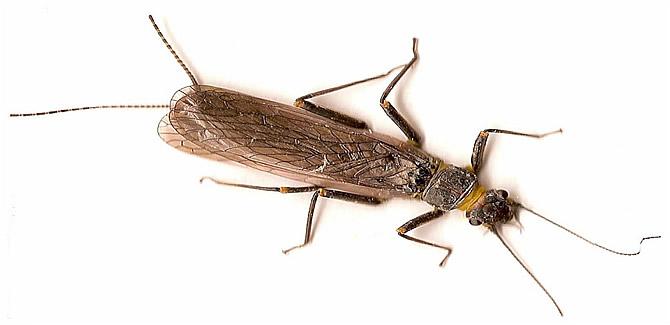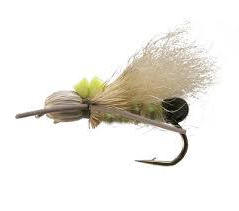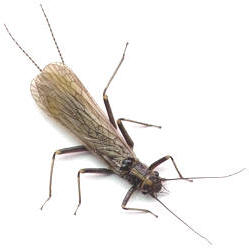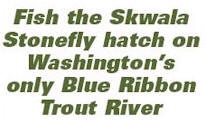
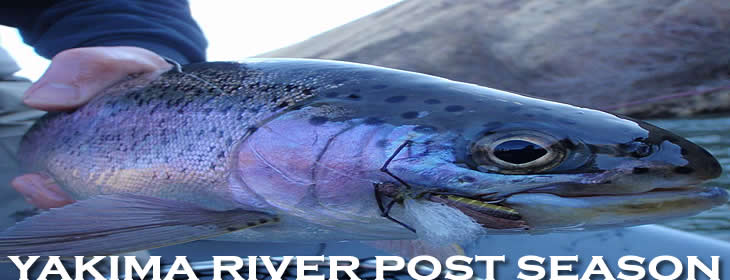
|
|
||||||||
|
The cool, early months of spring in the Central Washington Valley, are the beginning of a new fly fishing season on the Yakima River. Known widely with its critics for its tempermental and demanding trout as well as its fast, high water flows most of the year, the Yakima River has now joined the ranks of the infamous trout rivers of the west. Here, you will experience some of the finest fly fishing the Pacific Northwest has to offer. A bold statement, but one I stand by with over twenty five years of guiding experience on its waters. There is an exciting change taking place in the Yakima River Watershed that has been absent for over 5 decades. Most fly anglers that fish its waters on a regular basis aren't even aware. Driven entirely by the Yakima Indian Nation, restored returns of anadromous salmon stocks are vacillating some of the best trout fishing the state has to offer. Each year, Spring Chinook, Sockeye and Coho Salmon are returning to the headwaters of the Yakima River, where they once profilerated the stream by the thousands. You may ask, how do salmon returns correspond to trout fishing? Here is how. | ||||||||
| ||||||||
|
The enormous bio-mass of three uniquely different salmon, that had been absent from the Yakima for over fifty years are now impregnating the river and rejuvenating its overall health. After the salmon spawn in the fall, the eggs, flesh and salmon fry are a massive food source not only for the trout and other fish species, but also for the aquatic invertabrates and other critters living in the watershed. The Yakima River, nows experience monolithic hatches of Stoneflies, Mayflies and Caddisflies throughout the year, unlike we have seen in past seasons. Our finely finned, wild rainbow and cutthroat are growing in girth, as they take advantage of the plentiful food supply that is now abundunat. |
||||||||
|
|
||||||||
|
These post winter stoneflies are becoming legendary and perhaps are beginning to over shadow their May predecessors, the giant Salmonfly. Even when the most novice of fly fishermen hears the term "Skwala" they squirm with anticipation at the chance to fish this magical time. Perhaps, the legend and the hype have some fertility? This post winter stonefly, has two uniquely different life cycles and both are of major importance to trout as well as the fly angler. Understanding the science of both cycles, should increase your catch percentages and your fly fishing game on the stream. To understand them, you first must study their behavior. |
||||||||
|
||||||||
|
“In our family, there was no clear line between religion and fly fishing. We lived at the junction of great trout rivers in western Montana, and our father was a Presbyterian minister and a fly fisherman who tied his own flies and taught others. He told us about Christ's disciples being fishermen, and we were left to assume, as my brother and I did, that all first-class fishermen on the Sea of Galilee were fly fishermen and that John, the favorite, was a dry-fly fisherman.” ― Norman Maclean, A River Runs Through It |
||||||||
|
||||||||
|
Now, on to fly fishermen's favorite part.
The majority of fly
fishermen love to dry fly fish, most to a fault.
Watching a trout rise to a dry fly that you have
presented is what propels the sport of trout
fishing. I
have to honestly admit, I am
probably one of the biggest junkies out there.
However, stubborness can back fire
on you and keep you in a stagnet learning curve
that you may have a hard time over coming.
You need to get over it! Nymph fishing is not bait
fishing! The majority of nymph patterns
are tied with feather and fur.
As fly fishermen, we are tuned and trained to match the specific food source of fish. Dry fly patterns that mimic adult insects are fun to fish. However, if the trout are keyed on migrating nymphs then convincing them to eat an adult can be futial. If a "BigMac" was placed right in front of you, would you decline it for a different choice that you had to move to go get? I would bet my next paycheck that the majority faced with this decision would devour the burger. Remember, trout will begin eating under the surface of the water, before any surface feeding can occur, because that is where the lifecycles of most river insects begins.
So, their peak adult activity levels are going fall in the afternoon. Cooler morning and night time lows this time of year are still considered to be in the winter range. Rarely will you see female stoneflies flutter in the air, across the river. More times than not, they slowly emerge from the structure along the shoreline and crawl to the surface edges, where they drift along the current line and can begin their egg laying processes. So, if you approach the river in the morning, most likely your day will begin working those migration routes with various stonefly nymph patterns. As the day warms and you watch with a careful eye, you should have a chance to switch to a surface pattern and begin presenting a drag free presenation to those trout that are looking for adult Skwalas. The fish are already stationed in the migration routes, so changing your water types and tactics is minimal...correct?. The end of the migration route is typically the shallowest portion, so clear water conditions will dictate, a flawless presentation with a dry fly. The next biggest question I receive from clients is, "when is the Skwala fishing good"? Here is the answer. Much like any stonefly hatch, it's about timing. What I can tell you from over thrity years of experience is when the game is on, be ready to go. That mean's, when we annouce the Skwala fishing is on, drop everything and get to the river, especialy for Skwala fishing. Why? Because spring conditions can change from day to day, hour to hour. Rarely, do we ever see river conditons remain optimal for weeks at a time, during the peak of the Skwala fishing. It may be dynamite one day and the river a bloody mess the next. Their emergence is predetermined in accordance with spring run-off and it happens during the months of February, March & April. So when the female adults start showing up on the water, it takes very little time for trout to adjust and begin recognizing them. They have already been eating nymphs for weeks, perhaps months right. The transition doesn't take long and they react within accordance of what the hatch dictates. Most years, the river bounces back and forth between optimal flows and "blown out" conditions. What I can honestly tell you is that the Skwala hatch occurs over a long extended period because of this fact. When we see a change in river conditions, the stoneflies, both nymph and adult will stop their activity all together and will wait unitl improvements in flows have stablized. Imagine the nymphs trying to move in flood stage conditions, when the river is bank to bank and raging at extreme flow. Like other creatures, they hunker down and ride the storm out. That is one of the reasons why, we see the hatch progress well into the month of April, especially in the Upper Yakima River above Ellensburg. In late March & April, you can witness Skwala Stones, March Brown Mayflies and Blue Wing Olive Mayflies all coming down the same seam lines of the river. It's an all out food blitz and of course, trout are eating a combination of food forms then and are distracted by the existance of the mayflies.
|
||||||||
|
If good Skwala fishing is your target, look to
the months of late February and March to be the
prime months, when trout are stead fast and
eatn' em. Once the mayflies hatches begins in April,
we find the attention of trout focus on a
variety of food forms and not so much on just
one. The video above is from Skwala fishing in the Yakima River "Farmlands" in 2017 and was
shot the first week of April. Our flows in
February and March were at constant flood
stage, so the Skwala hatch was pushed out, which is fairly common. If Skwala fishing is on your target for early spring this season, this should give you a good idea of what you can expect. Plan accordingly and if you are looking to fish the river with a WBFC guide, I would suggest getting your date down asap. Skwala fishing is very popular and it is also a time of the year, when our guiding rates still remain in at our post-season levels. |
||||||||
|
|
||||||||
|
|

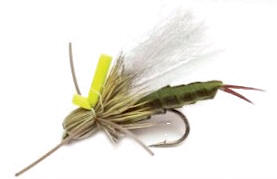 So with that now said, this paragraph brings
me to the first major topic of the fly
fishing season.
One of the most anticipated, aquatic insect
hatches on the Yakima, known widely in the
"dryfly freaks" fishing circles as the
"Skwala" or "
So with that now said, this paragraph brings
me to the first major topic of the fly
fishing season.
One of the most anticipated, aquatic insect
hatches on the Yakima, known widely in the
"dryfly freaks" fishing circles as the
"Skwala" or "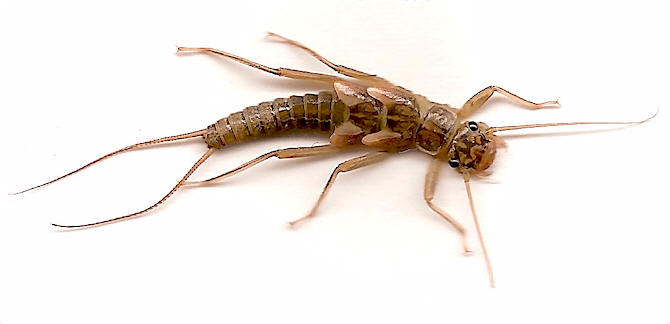
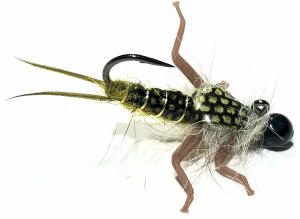
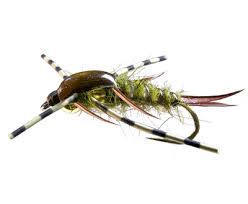 These are learned behaviors and habits and
anyone that
has spent years studying and observing it, will
tell you the same tale. Any
guide worth his weight, should be able to
understand and explain it.
These are learned behaviors and habits and
anyone that
has spent years studying and observing it, will
tell you the same tale. Any
guide worth his weight, should be able to
understand and explain it.
